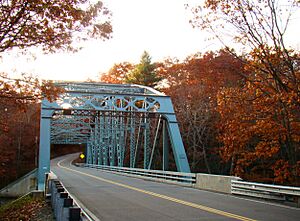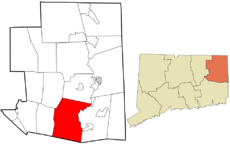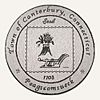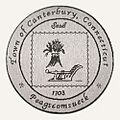Canterbury, Connecticut facts for kids
Quick facts for kids
Canterbury, Connecticut
|
||
|---|---|---|

Butts Bridge over the Quinebaug River
|
||
|
||
 Windham County and Connecticut Windham County and Connecticut |
||
| Country | ||
| U.S. state | ||
| County | Windham | |
| Region | Northeastern CT | |
| Incorporated | 1703 | |
| Government | ||
| • Type | Selectman-town meeting | |
| Area | ||
| • Total | 40.2 sq mi (104.1 km2) | |
| • Land | 39.9 sq mi (103.3 km2) | |
| • Water | 0.3 sq mi (0.7 km2) | |
| Elevation | 351 ft (107 m) | |
| Population
(2020)
|
||
| • Total | 5,045 | |
| • Density | 125.50/sq mi (48.463/km2) | |
| Time zone | UTC-5 (EST) | |
| • Summer (DST) | UTC-4 (EDT) | |
| ZIP code |
06331
|
|
| Area code(s) | 860/959 | |
| FIPS code | 09-12130 | |
| GNIS feature ID | 0213403 | |
Canterbury is a small town in Windham County, Connecticut, United States. It is part of the Northeastern Connecticut Planning Region. In 2020, about 5,045 people lived in Canterbury.
Contents
History of Canterbury
The area where Canterbury is now was first settled by English colonists in the 1680s. It was called Peagscomsuck back then. This land was officially separated from a nearby area called Plainfield in 1703. That's when it got its current name, Canterbury, which comes from the city of Canterbury, England.
Prudence Crandall's School (1831–1834)
Canterbury was an important town in the early 1800s. It was known for its leaders and friendly community. Many influential people lived there, working together to improve the town.
In 1832, a schoolteacher named Prudence Crandall caused a big stir. She was a Quaker and decided to open the Canterbury Female Boarding School. The controversy started when she began admitting black girls as students.
A powerful resident of Canterbury, Andrew T. Judson, led efforts against the school. The state government of Connecticut even passed a "Black Law." This law made it illegal to teach black children who came from outside the state.
Prudence Crandall bravely continued teaching. In 1833, she was arrested and spent a night in jail. Even though there were long legal battles, a group of angry residents used violence. This forced the school to close in 1834. Crandall then left Connecticut and never came back. The "Black Law" was finally removed in 1838.
Years later, in 1877, the town of Canterbury recognized Prudence Crandall. She had moved to Elk Falls, Kansas, and was living in poverty. The town gave her a small pension, which helped her a lot. She passed away in 1890.
Prudence Crandall's Legacy and Honors
In 1995, the Connecticut state government honored Prudence Crandall. They named her the state's official heroine. This was because she opened the very first school in the United States for black girls.
Her school building still stands in Canterbury today. It is now the Prudence Crandall Museum. This museum is a National Historic Landmark and a popular place for tourists to visit in Canterbury.
In 2009, a life-size bronze statue was placed in the state capital. It shows Prudence Crandall with an African-American student.
Geography of Canterbury
Canterbury covers a total area of about 40.2 square miles (104.1 square kilometers). Most of this area, about 39.9 square miles (103.3 square kilometers), is land. A small part, about 0.2 square miles (0.7 square kilometers), is water.
Population and People
| Historical population | |||
|---|---|---|---|
| Census | Pop. | %± | |
| 1820 | 1,984 | — | |
| 1850 | 1,669 | — | |
| 1860 | 1,591 | −4.7% | |
| 1870 | 1,543 | −3.0% | |
| 1880 | 1,272 | −17.6% | |
| 1890 | 947 | −25.6% | |
| 1900 | 876 | −7.5% | |
| 1910 | 868 | −0.9% | |
| 1920 | 896 | 3.2% | |
| 1930 | 942 | 5.1% | |
| 1940 | 992 | 5.3% | |
| 1950 | 1,321 | 33.2% | |
| 1960 | 1,857 | 40.6% | |
| 1970 | 2,673 | 43.9% | |
| 1980 | 3,426 | 28.2% | |
| 1990 | 4,467 | 30.4% | |
| 2000 | 4,692 | 5.0% | |
| 2010 | 5,132 | 9.4% | |
| 2020 | 5,045 | −1.7% | |
| U.S. Decennial Census | |||
As of the 2020 census, Canterbury had a population of 5,045 people. The town has grown over the years, with more people choosing to live there.
Arts and Culture in Canterbury
Canterbury has several interesting places to visit that show its history and culture.
Museums and Other Points of Interest
- Canterbury Center Historic District – This area includes buildings with old architectural styles. You can find it along roads like Elmdale, Library, and North Canterbury.
- Capt. John Clark House – A historic house located south of Canterbury on Route 169.
- Jonathan Wheeler House – Another historic house found on North Society Road.
- March Route of Rochambeau's Army: Manship Road-Barstow Road – This marks a path taken by soldiers during the American Revolutionary War.
- Prudence Crandall House – This is the former school of Prudence Crandall, now a museum. It's at the corner of CT 14 and 169.
- Westminster Congregational Church – A historic church in the town.
- FaithWay Community Church – A church located on South Canterbury Road.
Education in Canterbury
Students in Canterbury attend schools run by the Canterbury School District.
Local Schools
- Canterbury Elementary School: This school is for students from Kindergarten through fourth grade. Their mascot is the Kitt Fox.
- Dr. Helen Baldwin Middle School: This school serves students from fifth through eighth grade. The bulldog is their mascot.
High School Options
Canterbury does not have its own high school. Because of this, students have several choices for high school. They can attend:
- H.H. Ellis Technical High School
- Griswold High School
- Killingly High School
- Norwich Technical High School
- Norwich Free Academy
- Woodstock Academy
Notable People from Canterbury
Many interesting people have connections to Canterbury:
- John Adams (1772–1863) – Born in Canterbury, he was an educator who helped organize many Sunday schools.
- Horace Austin (1831–1905) – The sixth governor of Minnesota, born in Canterbury.
- Margaret Wise Brown (1919–1952) – A famous author of children's books.
- Asa B. Carey – A brigadier general in the U.S. Army.
- Moses Cleaveland (1754–1806) – A surveyor born in town, the city of Cleveland, Ohio, is named after him.
- Prudence Crandall (1803–1890) – A brave schoolteacher who opened a school for black girls in Canterbury.
- Sarah Harris Fayerweather (1812–1878) – The first black student to attend Prudence Crandall's school.
- Luther Jewett (1772–1860) – A United States Representative from Vermont, born in Canterbury.
- Ephraim Paine (1730–1785) – A delegate for New York to the Continental Congress, born in Canterbury.
- Charles Rocket (1949–2005) – An actor who lived and died in Canterbury.
- Jeptha Root Simms (1807–1883) – A historian and geologist, born in Canterbury.
- Loren P. Waldo (1802–1881) – A U.S. Representative.
- Joseph Williamson – Born in Canterbury and served as President of the Maine Senate.
- William Durkee Williamson (1779–1846) – A governor of Maine, born in Canterbury.
Images for kids
-
Butts Bridge over the Quinebaug River
See also
 In Spanish: Canterbury (Connecticut) para niños
In Spanish: Canterbury (Connecticut) para niños






